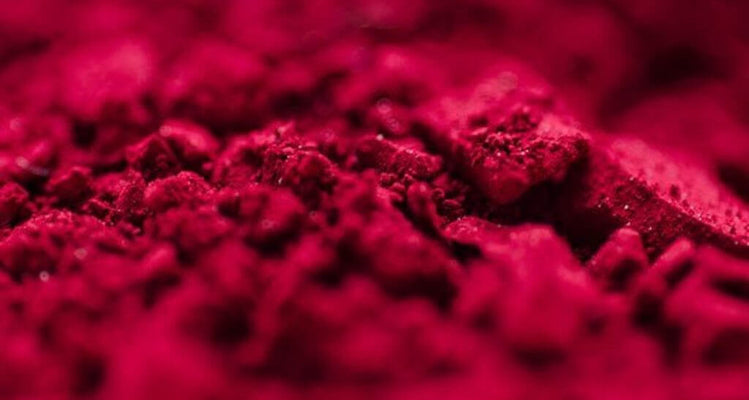The use of carmine in cosmetics like lipstick and eye shadow has been one of the primary concerns with halal cosmetics. A chemical extract from the Cochineal and Porphyrophora insect species, carmine (or carminic acid) is what gives many cosmetics their brilliant red colour. However, foods such as yoghurt, juice, syrups, sauces, and candies could also contain carmine.
The making process of Carmine
The cochineal beetle, a scale insect that lives its entire life adhering to prickly pear cacti in Central and South America, is the source of the dye. The majority of this bug, which has been harvested for hundreds of years or more, is currently gathered on prickly pear fields in Peru and the Canary Islands.
With an average yearly export of 70 tons, Peru is the main exporter of this dye. That's a lot of bugs when you realize that 70,000 cochineal insects are required to produce just one pound of dye.
The prickly pear pads are gathered, stored in warehouses, and then the bugs are removed by personnel. It is challenging to retrieve the female cochineal because it spends its entire existence burrowed into the plant.
After being removed, they are sorted and dried in the sun. The beautiful red colour of the bug bodies is then seen after they are crushed. The contrast is striking because the bugs' exteriors are covered in white powder for protection.
The dye that will be utilized is then brought out by mixing the crushed bugs with an acidic alcohol solution. Because of this, the colour is sometimes known as cochineal extract.
For certain colour effects, the dye may occasionally be used with a solution like borax. This produces a highly vivid red pigment when combined with water and other fluids. It is suitable for many different items and comes in a variety of red colours.

Is Carmine safe for eating?
Carmine was previously permitted by the U.S. Food and Drug Administration to appear on labels as "natural dyes." But when it was learned that some people can experience severe allergic responses from this colour, including anaphylaxis, it was agreed that it ought to be clearly marked on products.
The dye is now labelled with one of the following names: carmine, cochineal, cochineal extract, crimson lake, carmine lake, carminic acid, or natural red 4.
It has no special health dangers because it is made from a natural ingredient. In comparison to many of the more hazardous dyes now on the market, it is also thought to be a usually renewable resource.
People dislike bugs, so when it was revealed what the dye was composed of, there were a lot of uproars. But, if you can wrap your head around it, it's a better choice than the other ones.
Alternative dyes like Red 40 and Red 2 are produced using coal tar and petroleum, both of which are non-renewable resources. Additionally, it has been related to a number of medical disorders, such as allergies, cancer, ADHD, and attention-deficit hyperactivity disorder (ADHD).
Food colouring dangers and effects on health are investigated by the Center for Science in the Public Interest (CSPI), a consumer advocacy group with headquarters in Washington, D.C. In their report Food Colours: A Rainbow of Risks, you can read about their worries over these carcinogen-containing dyes.
Carmine starts to look a lot more tempting when we consider how hazardous these petroleum-based food colours are.
Is Carmine considered halal?
As it comes from an insect, many people have questioned whether or not eating carmine is deemed halal. As a result, it's crucial to investigate Islamic teachings on eating insects and comprehend what exactly qualifies as an "animal product" instead of a manufactured or chemical substance.
Hanafi, Maliki, Shafi'i, and Hanbali are the four fundamental schools of the Islamic law that have issued pronouncements on what is and is not permissible for consumption.

Hanafi
According to the Hanafi, some insects, including those from the locust and grasshopper species, are acceptable for food. This is due to the fact that the prophet Mohammed (PBUH) is known to have consumed grasshoppers or locusts while fighting.
Other insect species, such as beetles, flies, spiders, etc., are allegedly not regarded as acceptable because they lack blood, according to certain researchers. However, haemolymph is a form of blood that all insects regardless of species possess.
Haemolymph, which is a mixture of blood and lymphatic fluid, does not include red blood cells, in contrast to humans and other mammals.
Shafi’i and Hanbali
According to the Shafi'i and Hanbali, insects are unappealing and are not a suitable source of nourishment. In contrast, insects can be eaten if there is a dire need and no other food source is available.
Maliki
Eating insects is acceptable according to the Maliki school of thinking if they are killed and prepared for consumption first. In other words, devoid of any toxic substances. Carmine might be viewed in this context as an extract that has been prepared and processed for ingestion.
Ustadh Shuaib Ally stated that it is allowed to consume small numbers of insects if they are a component of another food item. Examples that are frequently used are an ant that accidentally fell into honey or a fly that accidentally fell into food and was cooked in it. Other instances include a bug that is present in produce or grains.
The difficulty in removing it or the fact that eating such a tiny amount is not regarded as repulsive since the bug has been assimilated into a greater quantity and is no longer comparable to eating an insect alone are the justifications offered for its legality.


